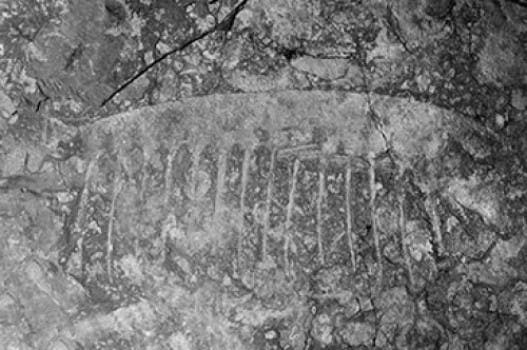Cambrian fossil is earliest example of large swimming filter-feeder.
An evolutionary explosion
Half a billion years ago, the world was extremely different. We’re in the Cambrian, the first geological period of the Paleozoic Era, which lasted from about 541 to 485 million years ago. Life is diversifying at an incredibly fast rate, into what we call today the “Cambrian explosion“. Basically, nature and evolution started experimenting with a myriad of life forms which were developing to fill in the empty biological niches. Until the Cambrian most organisms were simple, composed of individual cells occasionally organized into colonies, but during the period, they started diversifying at an incredibly fast rate. This is why Cambrian fossils are often remarkable and unique. Such is the case with Tamisiocaris borealis.
During the Cambrian, giant, fierce shrimp-like predators patrolled the world’s oceans, using sharp claws to snare their prey – it was a dog-eat-dog kind of world. However, Tamisiocaris was more of a gentle giant – using wispy, comb-like frontal appendages roughly 12 centimetres long to sweep up plankton as small as 0.5 millimetres. A new study conducted by University of Bristol researchers documents how it used these specialized appendages to filter out plankton, in a way much like whales to today.
How whales eat
You’d think that something as big as a whale eats something big, right? Well, you couldn’t be further from the truth! Many whales eat small organisms caught by straining seawater through a comblike structure found in the mouth called baleen. This is also the case of the blue whale – the largest creature to have ever existed on Earth. Curious that the largest thing on our planet would eat some of the smallest things on our planet, but that’s just evolution for you.
For Tamisiocaris, this strategy had a very clear and efficient purpose: while the competition for marine resources was extremely fierce, by changing its feeding strategy, it no longer needed to compete with the fiercest animals in the ocean for its food supply, says study co-author Jakob Vinther, a palaeobiologist at the University of Bristol, UK. This way, the animals “aren’t really a threat to anyone, and they don’t feel threatened either”, he says. This basically made it unique in the food chain – it had no natural enemies, and no real competitors for its food.
Not the best, but the first

Credit: Dr Jakob Vinther, University of Bristol
This type of evolutionary response has happened several times throughout Earth’s geological history, especially when there was an abundance of nutrients in the marine environment – like clearly there was in the Cambrian. But this is the first recorded case. Dr Vinther said:
“These primitive arthropods were, ecologically speaking, the sharks and whales of the Cambrian era. In both sharks and whales, some species evolved into suspension feeders and became gigantic, slow-moving animals that in turn fed on the smallest animals in the water.”
In order to better understand exactly how it fed, researchers developed
a 3D computer animation of the feeding appendage to explore the range of movements it could have made.
“Tamisiocaris would have been a sweep net feeder, collecting particles in the fine mesh formed when it curled its appendage up against its mouth,” said Dr Martin Stein of the University of Copenhagen, who created the computer animation. “This is a rare instance when you can actually say something concrete about the feeding ecology of these types of ancient creatures with some confidence.”
This discovery changed what researchers thought about them by 180 degrees – they believed Tamisiocaris to be nothing more than a failed evolutionary experiment – but the primitive arthropod was a pioneer, much ahead of its time:
“We once thought that anomalocarids were a weird, failed experiment,” said co-author Dr Nicholas Longrich at the University of Bath. “Now we’re finding that they pulled off a major evolutionary explosion, doing everything from acting as top predators to feeding on tiny plankton.”






